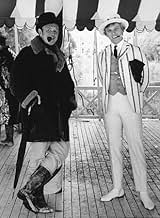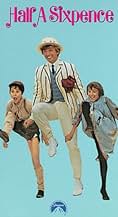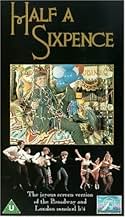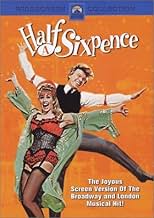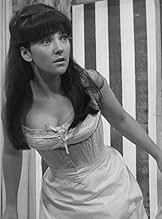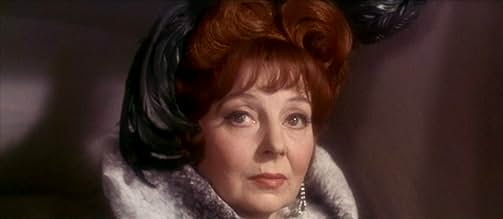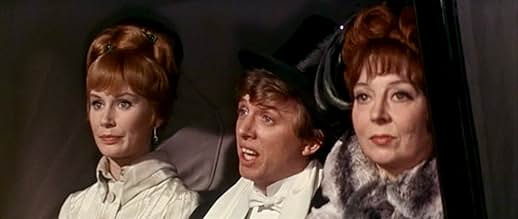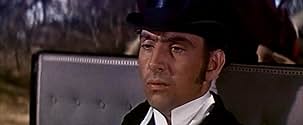Ajouter une intrigue dans votre langueArthur Kipps, an orphan apprenticed to a tyrannical owner of a mercantile, has a sudden abrupt change of life when his wealthy grandfather dies and leaves him a pile of money.Arthur Kipps, an orphan apprenticed to a tyrannical owner of a mercantile, has a sudden abrupt change of life when his wealthy grandfather dies and leaves him a pile of money.Arthur Kipps, an orphan apprenticed to a tyrannical owner of a mercantile, has a sudden abrupt change of life when his wealthy grandfather dies and leaves him a pile of money.
- Nominé pour le prix 1 BAFTA Award
- 2 nominations au total
Avis en vedette
I remember seeing this movie alot when I was little. They used to show on Tv here in NY in the late 60s and early 70s. I think the first time I first saw it was like in 67 or 68 I was like 5 or 6. The music is great most of the numbers are uplifting and Tommy Steel delivers them wondefully and so does the rest of the cast, especially the the ones with all the dancing like when they sing Money to Burn and Flash Bang Whallop. The one thing I didn't like about this movie was it had a great storyline that should of been developed stronger. The whole thing about the love between Artie and Ann and how it was almost destroyed because of new found wealth and the way it changed him and caused a rift between them and also between him and the boys he worked with could of been emphasized a little stronger. Other than that this movie is a gem, a wonderful, romping musical that you can watch with your whole family because theres's no excessive violence, sex or crude humor o
This is a very well acted and energetic musical. Tommy Steel and Julie Foster in the lead parts were brilliantly cast.
The banjo scene in this was well choreographed, put together and acted out. To top the whole scene the banjo playing was superb.
A brilliant family musical it gets a 10/10 from us. But then we are Tommy Steele fans.
The banjo scene in this was well choreographed, put together and acted out. To top the whole scene the banjo playing was superb.
A brilliant family musical it gets a 10/10 from us. But then we are Tommy Steele fans.
Here is a funny BIG frilly musical that is also a good comedy. Imagine someone moaning that it is too big, or even dreary! What a silly thing to feel when there is many musical scenes and easy comedy with which to have a great time. HALF A SIXPENCE is a British hybrid of TWO WEEKS WITH LOVE and HELLO DOLLY and belongs in that cinematic hat box of visual candy delights. If my mixed metaphors make sense (to those who know grammar...and grammar jokes). There is lovely film is all respects. It is raucous and silly and loaded with enough art direction and 'whalloping' stereo musical numbers to please even (Darling) Lili or even Leslie Caron at champagne best. HALF A SIXPENCE is actually a Teen musical but set in Victorian England. The dance numbers are just plain great, and humorous MGM veteran musical director George Sidney has delivered yet again. The music and tunes are memorable and if you see this film with educated kids, they get it and the experience is is a genuine family delight. A 'zac' in Oz vernacular is a sixpence...and there is more value than that in this DVD box of musical chocolates. Just enjoy it. Like those films also mentioned above. It has to be better than seeing Adam Sandler urinating on a door in BIG DADDY, the s-bend of 'family' movies for this clever new century.
Master showmen were at work in the production of this perhaps over long but nevertheless delightful picture. It would be impossible to visualise the film without the warm performance of Tommy Steele, and it was an inspired move to bring in George Sidney, one of Hollywood's finest directors of musicals, to give the picture a very special flare. The budget was obviously huge and it all shows on the screen in the very lively production numbers, especially those shot on location. A super piece of screen entertainment which stands up well to occasional re-watching.
Half A Sixpence is a musical adapted from the H.G. Wells story Kipps which Michael Redgrave played the title role back in a 1941 film version. I'm sure his interpretation of the role differed quite a bit from the boisterous styling of Tommy Steele in this film. They're so different in personality types.
It wasn't Wells the interpreter of the scientific future who wrote Kipps, but rather the Wells who was the Fabian Socialist. In a way this should be seen back to back with Pygmalion or My Fair Lady if you will. Some of the same themes were also done American style in The Unsinkable Molly Brown.
George Bernard Shaw when he wrote Pygmalion did the exact reverse of what Wells did in Kipps. That other noted Fabian Socialist took the flower girl Eliza and had her schooled in manners by the overbearing Henry Higgins to improve her station. Her economic status doesn't improve any, unless you figure she might marry well like the Freddy Eynsford-Hill character. She speaks well enough to fit in with his crowd.
But the exact opposite happens to Arthur Kipps. He's of illegitimate birth, apprenticed as a draper's assistant and living in the basement of his employer's store with other apprentices. But one fine day, Arthur's ship comes in, a grandfather leaves him an inheritance and a guaranteed annual income.
But unlike Audrey Hepburn, Tommy Steele is still at heart from the lower classes. So the story of Half A Sixpence is his personal struggle to find his place. That could be with a girl of his own class, Julia Foster or the previous unattainable Penelope Horner. Give you one guess where Steele winds up.
Half A Sixpence ran on Broadway for 511 performances in the 1965-66 season with Tommy Steele in the title role there. Steele's infectious style of performing is awfully hard to resist. Though he started out as a rock and roll singer, a British answer to Elvis Presley, Steele is really from the great tradition of Music Hall performers in the United Kingdom.
The socialist polemics are kept to a minimum here, I can't speak for how Wells originally wrote Kipps or how Michael Redgrave played it back in the day. But his points do come across and come across most entertainingly.
It wasn't Wells the interpreter of the scientific future who wrote Kipps, but rather the Wells who was the Fabian Socialist. In a way this should be seen back to back with Pygmalion or My Fair Lady if you will. Some of the same themes were also done American style in The Unsinkable Molly Brown.
George Bernard Shaw when he wrote Pygmalion did the exact reverse of what Wells did in Kipps. That other noted Fabian Socialist took the flower girl Eliza and had her schooled in manners by the overbearing Henry Higgins to improve her station. Her economic status doesn't improve any, unless you figure she might marry well like the Freddy Eynsford-Hill character. She speaks well enough to fit in with his crowd.
But the exact opposite happens to Arthur Kipps. He's of illegitimate birth, apprenticed as a draper's assistant and living in the basement of his employer's store with other apprentices. But one fine day, Arthur's ship comes in, a grandfather leaves him an inheritance and a guaranteed annual income.
But unlike Audrey Hepburn, Tommy Steele is still at heart from the lower classes. So the story of Half A Sixpence is his personal struggle to find his place. That could be with a girl of his own class, Julia Foster or the previous unattainable Penelope Horner. Give you one guess where Steele winds up.
Half A Sixpence ran on Broadway for 511 performances in the 1965-66 season with Tommy Steele in the title role there. Steele's infectious style of performing is awfully hard to resist. Though he started out as a rock and roll singer, a British answer to Elvis Presley, Steele is really from the great tradition of Music Hall performers in the United Kingdom.
The socialist polemics are kept to a minimum here, I can't speak for how Wells originally wrote Kipps or how Michael Redgrave played it back in the day. But his points do come across and come across most entertainingly.
Le saviez-vous
- AnecdotesAfter the critical and commercial failure of the film, director George Sidney retired from directing at the age of only 51.
- GaffesIn the song, "Money to Burn", where Kipps (Tommy Steele) is playing the banjo, it's obvious that he's simply playing along to an audio track. But the sound begins several times before he does the strumming to make it happen. This should have been watched/caught in the editing process.
- Citations
Harry Chitterlow: Don't forget old Harry. For £100, I'll let you have a quarter share of my new play.
Arthur Kipps: A quarter share? I'll take half!
Harry Chitterlow: Spoken like a gent!
- ConnexionsFeatured in The 100 Greatest Musicals (2003)
Meilleurs choix
Connectez-vous pour évaluer et surveiller les recommandations personnalisées
- How long is Half a Sixpence?Propulsé par Alexa
Détails
- Date de sortie
- Pays d’origine
- Langue
- Aussi connu sous le nom de
- Tatsız Miras
- Lieux de tournage
- Aylesford, Kent, Angleterre, Royaume-Uni(village where Kipps grows up)
- société de production
- Consultez plus de crédits d'entreprise sur IMDbPro
- Durée2 heures 23 minutes
- Rapport de forme
- 2.35 : 1
Contribuer à cette page
Suggérer une modification ou ajouter du contenu manquant


